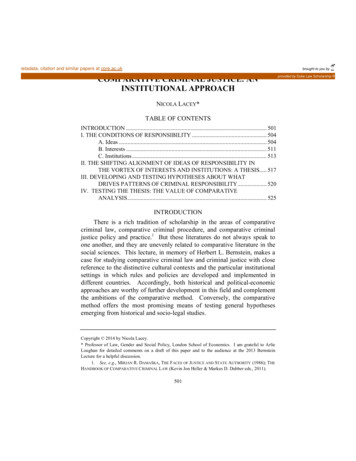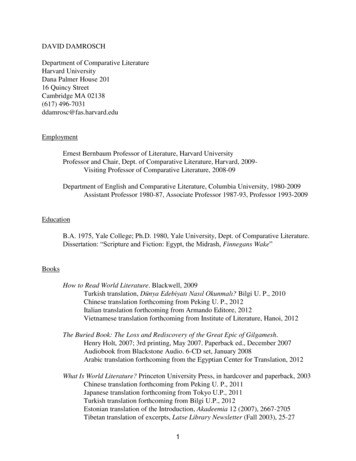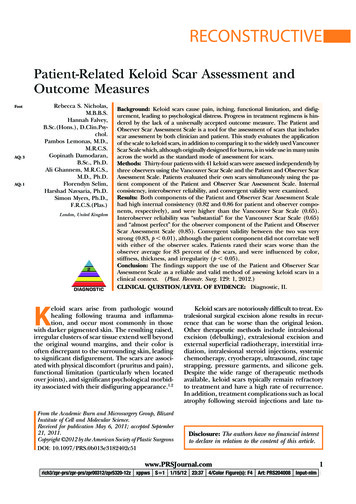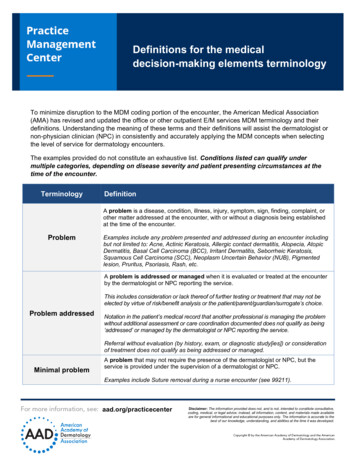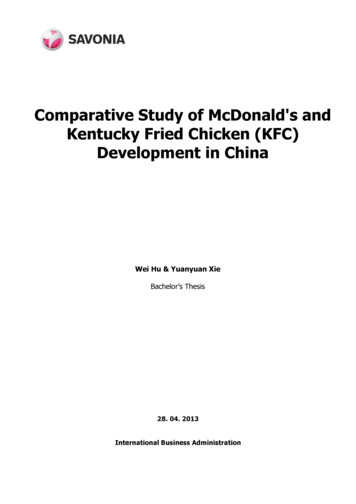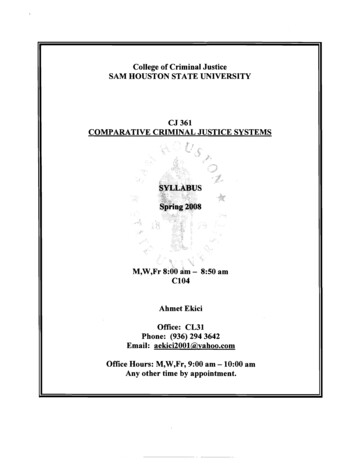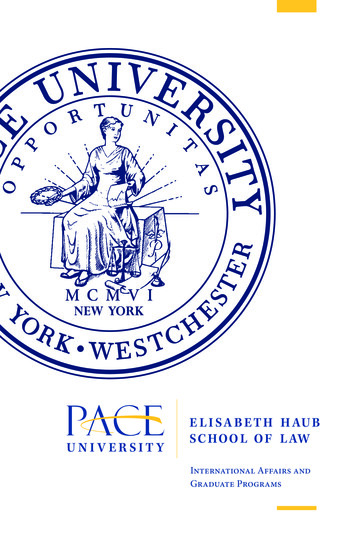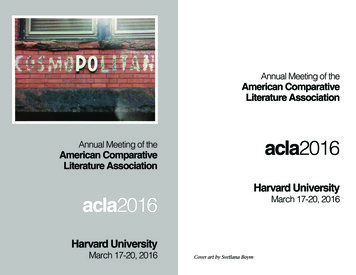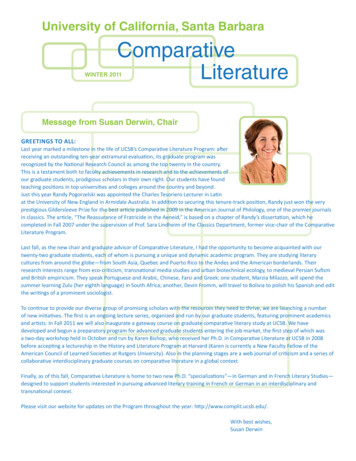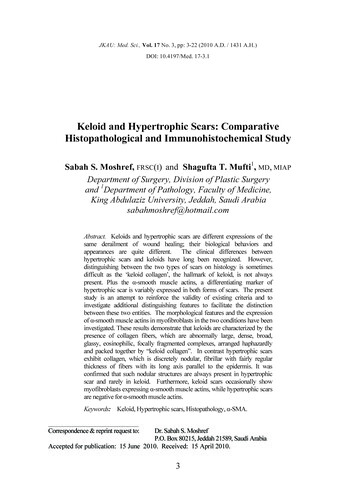
Transcription
JKAU: Med. Sci., Vol. 17 No. 3, pp: 3-22 (2010 A.D. / 1431 A.H.)DOI: 10.4197/Med. 17-3.1Keloid and Hypertrophic Scars: ComparativeHistopathological and Immunohistochemical StudySabah S. Moshref, FRSC(I) and Shagufta T. Mufti1, MD, MIAPDepartment of Surgery, Division of Plastic Surgeryand 1Department of Pathology, Faculty of Medicine,King Abdulaziz University, Jeddah, Saudi Arabiasabahmoshref@hotmail.comAbstract. Keloids and hypertrophic scars are different expressions of thesame derailment of wound healing; their biological behaviors andappearances are quite different.The clinical differences betweenhypertrophic scars and keloids have long been recognized. However,distinguishing between the two types of scars on histology is sometimesdifficult as the ‘keloid collagen’, the hallmark of keloid, is not alwayspresent. Plus the α-smooth muscle actins, a differentiating marker ofhypertrophic scar is variably expressed in both forms of scars. The presentstudy is an attempt to reinforce the validity of existing criteria and toinvestigate additional distinguishing features to facilitate the distinctionbetween these two entities. The morphological features and the expressionof α-smooth muscle actins in myofibroblasts in the two conditions have beeninvestigated. These results demonstrate that keloids are characterized by thepresence of collagen fibers, which are abnormally large, dense, broad,glassy, eosinophilic, focally fragmented complexes, arranged haphazardlyand packed together by “keloid collagen”. In contrast hypertrophic scarsexhibit collagen, which is discretely nodular, fibrillar with fairly regularthickness of fibers with its long axis parallel to the epidermis. It wasconfirmed that such nodular structures are always present in hypertrophicscar and rarely in keloid. Furthermore, keloid scars occasionally showmyofibroblasts expressing α-smooth muscle actins, while hypertrophic scarsare negative for α-smooth muscle actins.Keywords: Keloid, Hypertrophic scars, Histopathology, α-SMA.Correspondence & reprint request to:Dr. Sabah S. MoshrefP.O. Box 80215, Jeddah 21589, Saudi ArabiaAccepted for publication: 15 June 2010. Received: 15 April 2010.3
4S.S. Moshref and S.T. MuftiIntroductionHypertrophic scars and keloids are macroscopic cutaneous scarringcaused as the result of disturbance of wound healing, which occurs onpredisposed individuals. It shows a kind of over-healing, producing overabundant wound matrix responsible for raised, red, inflexible scar tissue,which causes itching and pain. It can also lead to serious functional andcosmetic concerns[1-5]. Excessive scarring following trauma that createstissue loss is identified into two types; hypertrophic scars and keloidscars.The first is known as hypertrophic scars, and they remain confined tothe boundaries of the original lesion, generally regressing spontaneouslyafter the initial injury. They may produce scar contractures e.g., whenlocated over joints. Most hypertrophic scars do not recur after surgicalexcision.The second type of excessive scarring that develops from either adeep or a superficial injury is known as a keloid scar. Keloids are alsored and itchy. Thus, they exceed the boundaries of the initial injury asthey do not regress with time, or with high recurrent rate after surgicalexcision, and usually they do not provoke contractures[1,2,4].Individuals of all ethnic backgrounds can form keloid andhypertrophic scars as a familial predisposition was believed to exist.Keloid formation is approximately 15 times greater in highly pigmentedethnic groups than in whites. The pathogenesis of keloid scar is complexwhich involves both genetic and environmental factors[2,6].Distinguishing hypertrophic scar from keloid histopathologically maypresent a diagnostic challenge. Several methods and techniques are usedto investigate the features of both entities in order to facilitate theirdifferentiation. Histopathological studies and immunohistochemicalstudies are among the most extensively applied criteria.Histopathological differences between keloid and hypertrophic scarhave been reported using hematoxylin and eosin stain. Among thesedifferences, keloid scar is characterized by the presence of thick,hyalinized collagen bundles or ‘keloid collagen’ with mucinous groundsubstance and relatively few fibroblasts. Conversely, little or no keloidalcollagen is found in hypertrophic scar. A histopathological characteristicof hypertrophic scar is the presence of nodules containing a high density
Keloid and Hypertrophic Scars 5of cells and collagen. The collagen fibers are cigar-shaped and runparallel to the surface of the skin. They are located in the middle ordeeper layer of the scar, and are oriented along the tension lines of thescar. The absence of such nodules is characteristic of keloid scars.Hypertrophic scars have numerous fibroblasts but few glassy collagenbundles and scanty mucinous ground substance. Collagen fibers in theordinary and hypertrophic scars are oriented parallel to the long axis ofthe scar, whereas in keloid, collagen is arranged in a haphazardpattern[3,4,7-9].The objective of this study is to investigate the morphologicalfeatures in depth; the possible biologically and diagnostically relevantdifferences between keloid and hypertrophic scar using histopathologicaland immunohistochemical studies. The organization of collagen fiberswas determined by hematoxylin and eosin stained sections. The presenceor absence of myofibroblasts was demonstrated by α-smooth muscleactin (α-SMA) immunostaining. Such distinctive features may help inunderstanding the pathogenesis of these lesions; their differentiation andinterpretation of the clinical behavior. Furthermore, planning themanagement since keloid is more difficult to treat and is highly recurrentwith frustrating management.Material and MethodsThis study was conducted as part of a research project to study theabnormal scars in patient treated in the plastic surgery unit at KingAbdulaziz University Hospital (KAUH).Thirty-five samples ofhypertrophic, keloid and normal scars were collected and sorted based onclinical diagnosis obtained from the record of patients. Samples weretaken from excised skin scars during patient’s management, the Ethicsand Research Committee approved this study as fulfilling the ethicalrequirements. Written consent was obtained from patients beforeoperative excision of scars.Histopathological Study with Light MicroscopeFormalin fixed, paraffin embedded tissue sections were stained withhematoxylin and eosin, and examined in detail under a light microscope.The following histological and histopathological features of eachparameter, with the variable findings, were used to evaluate and
6S.S. Moshref and S.T. Muftidifferentiate the scars as normal, hypertrophic or as a keloid scar. Theparameters and their variable findings are: Epidermis (normal finding or flattened or hyperplastic) Epidermal features associated (hyper parakeratosis orhypergranulosis or spongiosis) Basal cell organization (regular palliate or disarray) Basal cell vacuolar change (present or absent) Papillary dermis (normal or scarring) Collagen site (papillary or reticular dermis) Collagen arrangement (haphazard, nodules or parallel to the skinsurface) Collagen quality (large, broad hyalinized or fibrillar, regular orwavy) Collagen cellularity (Myofibroblasts: numerous, scant oracellular) Horizontal fibrous bands in upper reticular dermis (prominent orinconspicuous) Advancing edge underneath epidermis (present or absent) Myxoid extracellular matrix (present or absent) Orientation of blood vessels (horizontal, vertical or aggregating) Inflammatory infiltrate (mild or moderate and its location) Mast cells (present or absent)Immunohistochemical StudyImmunohistochemical staining using an automated stainer with theavidin-biotin-peroxidase complex method was performed using theantibody α-SMA (dilution 1:50 Dako, Carpentaria, CA, USA). Resultswere scored as follows: (-) not seen. ( /-) rare/focal positivity. ( ) diffuse positivity.Positive and negative controls were performed for the stain.However, since α-SMA always stains the vessels, it was used as aninternal positive control. Each of the histopathological parameters wereevaluated and graded with a qualitative score of present or absent.
Keloid and Hypertrophic Scars 7The presence or absence of myofibroblasts was demonstrated by αSMA immunostaining in normal scar, keloid and hypertrophic scar.The diagnosis of keloid was based on the clinical characteristics,among which extension of the scar beyond the original wound andgrowth in mounds over mounds were the most definitive diagnosticfeatures. In those cases where these features were uncertain, thediagnosis was supported by history of the lesion progressively enlargingfor long duration (more than 6 months) and post excision recurrence.Cases which fell short of these considerations were excluded from thestudy. Presence of advancing front was recorded as positive or negativein the specimens, where the scar border was visible in the sections. Thediagnosis of hypertrophic scar was based on the clinical characteristicsamong which the most definitive feature was the lesion remainingconfined to the boundaries of the original wound with history ofregression spontaneously after the initial injury. A scar was consideredas normal when injury healed without becoming red, raised, or rigidwhen compared to a normal skin.ResultsDetailed histopathological examination of the keloid, hypertrophicand normal scars revealed various morphologic features; results aresummarized in Tables 1, 2 and 3.Table 1. Histopathological features seen on light microscopy in the epidermis.Histopathological FeaturesEpidermisNormal thickness withrete ridgesNormal thickness withflatteningHyperplasticEpidermal features asal cell organizationRegular palliatingDisarrayBasal cell vacuolar changePresentAbsentNormal ScarsN 10Hypertrophic ScarsN 1024Keloid ScarsN 15101051010310103151514911913237281414
S.S. Moshref and S.T. Mufti8Table 2. Histopathological features seen on light microscopy in the dermis.HistopathologicalFeaturesNormal ScarsN 10Hypertrophic ScarsN 10Keloid ScarsN 15Papillary dermisNormal1Scarring91014110 (Papillary dermis &upper half of reticular)10 (Papillary dermis &upper one third ofreticular)15 (Papillary dermis & fullthickness of reticular)Collagen siteCollagen arrangement and quality15 (large, broad, glassy,eosinophilic focallyfragmented complexes)Haphazard10 (fibrillar & of fairlyregular thickness)NodulesParallel toskinWavy101010 (delicate)Collagen 0 (absent)1 (inconspicuous)10Horizontal fibrous bands in upper reticular dermisProminentAbsent1410 (absent)Advancing edge underneath epidermisPresent12Absent101031010510 (horizontally)10 (vertically orientedaround the nodules)15 (aggregating below theepidermis with in or outgrowth)Myxoid extracellular matrixPresent10AbsentOrientation of blood vesselsChronic inflammatory infiltrateMildModerate10223LocationMast cells1511
Keloid and Hypertrophic Scars 9Table 3. α-SMA expression in fibroblastic cells of connective tissues.TissueScale-Normal scarHypertrophic scarn 10n 10- (in all)Keloidn 15- (in 10)α-SMA expression* /- / (in 5)Scale: - not seen; /- rare focal positivity; diffuse positivity.* Vascular walls are always labeled for α-SMAFig. 1. Hypertrophic scar 20 X showing epidermal flattening with scarring of papillarydermis and horizontally oriented wavy collagen fibers.Epidermal changes was illustrated in Table 1 as follows: Flatteningof epidermis was more prominent in hypertrophic scars (100%) (Fig. 1)and was only seen in 33.33% of keloid scars. Hyperkeratosis andhypergranulosis were consistent features in all types of keloid scars,hypertrophic scars and normal scars. Spongiosis is mostly apparent in93.33% of keloid scars, while it was only seen in 30% of each ofhypertrophic and normal scars (Table 1). Basal cell organization wasregular and palliating in keloid scars (86.66%), whereas hypertrophicscar showed disarray in 90% (Fig. 2). Basal cell disarray seen inhypertrophic scars correlated with the obliteration of the rete ridges anddiscrete flattening of the epidermis seen in all of these cases. Basal cellvacuolar change was diffusely prominent in the keloid scars (93.33%)(Fig. 3), but less common in hypertrophic scars (20%) and normal scars(30%). The presence of basal cell vacuolar change in the keloid group
10S.S. Moshref and S.T. Mufticorrelated with the added presence of spongiosis in all of these cases.Scarring of papillary dermis was very prominent in all hypertrophic scars(100%) and frequent in keloid scars (93.33%) and normal scars (90%).Fig. 2. Hypertrophic scar 40X showing epidermal disarray.Fig. 3. Keloid scar 40 X showing basal cell vacuolar change.The dermal changes was illustrated in detail in Table 2 as follows:The collagen was seen spanning full thickness of the dermis including thepapillary dermis in all keloid scars (100%), while it remained confined tothe upper one third of reticular dermis in all hypertrophic scars (100%).The normal scars collagen was confined to the upper half of the reticular
Keloid and Hypertrophic Scars 11dermis. The collagen quality in all keloid scars (100%) was that ofabnormally large dense, broad, glassy, eosinophilic, focally fragmentedcomplexes, arranged haphazardly (Fig. 4). These complex collagenbundles were shown to be associated with variable amounts of"extracellular myxoid matrix” in (86.66%) keloid scars. On the otherhand, the collagen in all hypertrophic scars (100%) was discretelynodular, fibrillar with fairly regular fiber thickness having their long axisparallel to the epidermis with no extracellular myxoid matrix (Fig. 5).Fig. 4. Keloid scar 40 X showing abnormally large dense, broad, glassy, eosinophilic,focally fragmented complexes, arranged haphazardly.Fig. 5. Hypertrophic scar 40 X showing nodules of fibrillary collagen of fairly regularthickness.
12S.S. Moshref and S.T. MuftiThe collagen in normal scars (100%) was wavy, delicate and parallel tothe long axis with no extracellular myxoid matrix. The collagen wascellular in (66.66%) keloid scars and in (100%) hypertrophic scars. Rarecellularity was a feature of normal scars. Presence of cellularity wascorrelated only to a small extent with the expression of α-SMA by thesecells; positive α-SMA indicates that the cells were myofibroblasts (Table3). Diffused positive α-SMA was seen only in (33.33%) keloid scars(Fig. 6: a, b, c), while all hypertrophic scars (100%) failed to showexpression of α-SMA (Fig. 7). Collagen in the nodules of hypertrophicscar were generally oriented parallel to each other. Horizontal fibrousbands in the upper reticular dermis were prominent in (93.33%) keloidscars (Fig. 4) and were absent in all (100%) of the hypertrophic andnormal scars. An advancing edge below the epidermis was present in(66.66%) keloid scars (Fig. 8), and was absent in all hypertrophic andnormal scars. Blood vessels were seen aggregating below the epidermisin all keloid scars (100%) with a tendency of growing towards or fromthe epidermis, were vertically oriented around the nodules in all (100%)the hypertrophic scars as compared to the horizontal orientation in all(100%) normal scars. Chronic inflammatory infiltrate was of moderatedegree in all (100%) keloid scars and was perivascular in location;scattered mast cells were seen in (73.33%) (Fig. 9).Fig. 6(a). Keloid scar 40 X showing broad glassy collagen.
Keloid and Hypertrophic Scars 13Fig. 6(b). Keloid scar 60 X showing α-SMA expressing myofibroblasts with glassy collagen.Fig. 6(c). Keloid scar 40 X showing diffuse positivity for α-SMA expressing myofibroblasts.
14S.S. Moshref and S.T. MuftiFig. 7. Hypertrophic scar 40 X showing absence of α-SMA expressing myofibroblasts.Note vertical blood vessels at the margins of collagen nodules.
Keloid and Hypertrophic Scars Fig. 8.Fig. 9.Keloid scar 20 X showing advancing edge below the epidermis.Keloid scar 40 X showing chronic inflammatory infiltrate and mast cell.15
16S.S. Moshref and S.T. MuftiHypertrophic scars showed mild perivascular chronic inflammatoryinfiltrate in 20%, with scattered mast cells confined to the reticulardermis and occasionally around blood vessels in 30%. Normal scarsshowed mild chronic inflammatory infiltrate in all 100%, with scatteredmast cells in 20%.DiscussionWhile there was little disagreement about distinctions concerning thegross appearance of keloid and hypertrophic scars, histopathologicaldifferences between them are often considered to be insignificant. Thereare conflicting reports in literature as to whether there arehistopathological distinctions between these two scars. These resultsconfirm and extend the reports of histopathological differences betweenkeloid and hypertrophic scars, these are:1) The first difference was in the epidermal features; the keloid scarsdemonstrated normal thickness of epidermis in all cases with regular andpalliating basal cell organization, and basal cell vacuolar change in mostcases. The papillary dermis show scarring in many keloid scars. On theother hand, the epidermis in all hypertrophic scars was flattened, withdisarray of basal cells in most cases and vacuolar change in few. Theseepidermal changes of keloid scars are concordant to other studies inliterature, and are suggestive of presence of prior external injury to thedermis locally. This correlates well with the fact that keloid scarringdevelops from either a deep or a superficial injury. In contrast, somestudies report epidermal hyperplasia in keloid, and this could beexplained partly, by the phenotypic variations in the studygroups[3,4,8,10,11].2) The second difference was the collagen quality and orientation ofthe scar; all keloid scars in our study demonstrated the presence of large,broad, glassy, eosinophilic focally fragmented and haphazardly arrangedcollagen complexes referred to as “keloid collagen” in association withvariable amounts of myxoid extracellular matrix in most cases. Asopposed to hypertrophic scar which showed nodules containing fibrillarcollagen of fairly regular thickness arranged parallel to the epidermis,with absence of myxoid extracellular matrix with high density of cells.Similar differentiating findings are reported in other studies[3,4,12,13].
Keloid and Hypertrophic Scars 17Verhaegen et al. found that compared with normal skin,normotrophic scar, and hypertrophic scar, the bundle distance wassignificantly larger in keloid scar, which confirms that thicker collagenbundles are present in keloid scar[14]. Abnormally, large collagen bundlecomplexes associated with variable amounts of "ground substance"mucopolysaccharides have been identified in keloid scar, but are absentfrom hypertrophic scars. This was explained by the fact that compared tonormal dermal fibroblasts keloid, fibroblasts exhibit increased productionof collagen and matrix metalloproteinase. Additionally, the keloidcollagen occupied full thickness of the reticular dermis in all cases, whileremained confined to the upper one third in the hypertrophic scars. Thisagain correlates with the exuberant amount of collagen and extensionbeyond boundaries of actual wounds in the keloid scar[4,12,13].3) The third difference was that “keloid collagen” showed positivityfor α-SMA expressing myofibroblasts in only one third of keloid scarswhile the collagen nodules of hypertrophic scars contained no α-SMAexpressing myofibroblasts, although they were cellular. There are widevariations in the literature regarding α-SMA expression in scars rangingfrom completely negative in keloid to 45% keloid cases positive, and thesame for hypertrophic scar, 70% positive to most cases in anotherstudy[3,15].Possible explanations for this variation between different studies are:(a) Differences in genetic backgrounds of the population studied (b)differences in the criteria used for diagnosing scars, positivity scales usedfor α-SMA expression; (c) presence of mixed keloid - hypertrophic scarsin the sample populations studied (d) interobserver variability.Histopathological characteristic of hypertrophic scar has the presenceof nodules containing a high density of cells and collagen similar inappearance to the nodules described in Dupuytren's contracture. Theyare cigar-shaped and run parallel to the surface of the skin, are located inthe middle or deeper layer of the scar, plus they are oriented along thetension lines of the scar. The absence of such nodules is characteristic ofkeloid scar. Myofibroblasts are differentiated fibroblasts found ingranulation tissue and fibrotic lesions. They differ from normalfibroblasts by their characteristic cytoplasmic bundles of microfilaments,nuclear indentations and cell-to-cell or cell-to-stroma connections.Moreover, a large proportion of myofibroblasts express smooth muscle
18S.S. Moshref and S.T. Muftiproteins such as α-SMA and desmin. It was well accepted thatmyofibroblasts appear temporarily in granulation tissue during woundhealing, but are present permanently in hypertrophic scars and otherfibrotic settings[4,16-18].4) The fourth difference was the presence of horizontal fibrous bandsin all keloid scars with an advancing edge underneath the epidermis in66% of cases, and the total absence of such features in all thehypertrophic scars. Similarly, these features have been reported in otherstudies. Some authors describe this phenomenon as “pseudopodia-likeextensions” into the surrounding tissue[3,8].5) The fifth difference was the presence of small aggregating bloodvessels just below the epidermis appearing to grow out or from it, in thekeloid scars, while in the hypertrophic scars the blood vessels wereoriented vertically around the nodules. Prominent telangiectasia in thepapillary dermis has been reported in keloid scars and vertically orientedblood vessels have been reported in the hypertrophic scars. The evidencedemonstrates that hypertrophic scars and keloids are hypoxic,undoubtedly due to the microvascular occlusion. Hypoxia may stimulateexcessive production of collagen, which forms the bulk of these lesions,from fibroblasts and myofibroblasts[3,7,19].6) The sixth difference was in the presence of moderate degree ofperivascular chronic inflammatory infiltrate in all keloid scars, with mastcells seen in the reticular dermis in 73%, as compared to hypertrophicscars where this feature was seen infrequent in 20-30% of cases.Immunohistochemical investigations have shown a high amount ofactivated immune-cell infiltrate in the excised keloid scars, consisting ofCD3 , CD4 , CD45R0[20,21].Several studies investigated the contribution of lymphocytes andmacrophages to keloid scarring by morphologically characterizinginflammatory cell subpopulations in keloid scars. It was found that therewas a significantly higher CD4 ( ):CD8( )(Th:Ts) ratio in keloid tissue,suggesting that an imbalance in these inflammatory cell subpopulationsmay contribute to keloid scarring mast cells in the middle dermis as theyare activated and may be involved in the pathogenesis of keloidscars[22,23].
Keloid and Hypertrophic Scars 19ConclusionThis report confirmed the diagnostic value of keloid collagen in all ofthe keloid scars in this present study group. Other features which favorthe diagnosis of keloid scar are the scarring of papillary dermis, presenceof horizontal fibrous bands and advancing front below the epidermis.Presence of horizontal blood vessels just below the epidermis, presenceof moderate degree of perivascular chronic inflammatory infiltrate withmast cells and variable α-SMA expression in the lesional myofibroblasts.On the other hand, it does confirm that hypertrophic scars diagnosticvalue includes cellular collagen nodules with vertically oriented vesselsat the nodule margins and absence of α-SMA expressing myofibroblasts.This present study indicates that α-SMA expression is variably seen inkeloid scars suggesting that this feature could not reliably help indistinguishing the two types of scars and that pathogenesis of keloid scarsis multifactorial and refutes the clonal theory of origin. This wassupported by a study of the morphology and biochemistry of keloid scarsby Knapp et al. who demonstrated multiple phenotypic differences incells derived from keloid scars[6,24]. Such distinctive features may help inunderstanding the pathogenesis of these lesions, their differentiation,interpretation of the clinical behavior and planning the appropriatemanagement of abnormal scar and avoid its a B, Ragunatha S, Inamadar AC. Scars in dermatology: Clinical significance.Indian J Dermatol Venereol Leprol 2008; 74(4): 420-423.Niessen FB, Spauwen PH, Schalkwijk J, Kon M. On the nature of hypertrophic scars andkeloids: a review. Plast Reconstr Surg 1999; 104(5): 1435-1458.Lee JY, Yang CC, Chao SC, Wong TW. Histopathological differential diagnosis ofkeloid and hypertrophic scar. Am J Dermatopathol 2004; 26(5): 379-384.Ehrlich HP, Desmoulière A, Diegelmann RF, Cohen IK, Compton CC, Garner WL,Kapanci Y, Gabbiani G. Morphological and immunochemical differences between keloidand hypertrophic scar. Am J Pathol 1994; 145(1): 105-113.Moshref S. Clinical and morphological difference between keloid and hypertrophic scars inpatient treated at KAUH – Jeddah. Egypt J Surg 2006; 25(4).Brissett AE, Sherris DA. Scar contractures, hypertrophic scars, and keloids. Facial PlastSurg 2001, 17(4): 263-272.Marneros AG, Norris JE, Watanabe S, Reichenberger E, Olsen BR. Genome scansprovide evidence for keloid susceptibility loci on chromosomes 2q23 and 7p11. J InvestDermatol 2004; 122(5): 1126-1132.Sharquie KE, Al-Dhalimi MA. Keloid in Iraqi patients: a clinicohistopathologic study.Dermatol Surg 2003; 29(8): 847-851.
21][22][23][24]S.S. Moshref and S.T. MuftiEnglish RS, Shenefelt PD. Keloid and hypertrophic scars. Dermatol Surg 1999; 25(8):631-638.David W. Disorders of collagen. In: WS, ed. The Skin. Symmers Systemic Pathology.London: Churchill Livingstone, Vol. 9, 3rd ed. 1992. 337.Bennet RG. Fundamentals of Cutaneous Surgery. St. Louis, Washington, DC: CVMosby, 1998. 709-719.Fujiwara M, Muragaki Y, Ooshima A. Keloid-derived fibroblasts show increasedsecretion of factors involved in collagen turnover and depend on matrix metalloproteinasefor migration. Br J Dermatol 2005; 153(2): 295-300.Uitto J, Kouba D. Cytokine modulation of extracellular matrix gene expression: relevanceto fibrotic skin diseases. J Dermatol Sci 2000; 24(Suppl 1): S60-69.Verhaegen PD, van Zuijlen PP, Pennings NM, van Marle J, Niessen FB, van der HorstCM, Middelkoop E. Differences in collagen architecture between keloid, hypertrophicscar, normotrophic scar, and normal skin: An objective histopathological analysis. WoundRepair Regen 2009; 17(5): 649-656.Kamath NV, Ormsby A, Bergfeld WF, House NS. A light microscopic andimmunohistochemical evaluation of scars. J Cutan Pathol 2002; 29(1): 27-32.Eddy RJ, Petro JA, Tomasek JJ. Evidence for the nonmuscle nature of the"myofibroblast" of granulation tissue and hypertropic scar. An immunofluorescence study.Am J Pathol 1988; 130(2): 252-260.Grinnell F. Fibroblasts, myofibroblasts, and wound contraction. J Cell Biol 1994; 124(4):401-404.Darby I, Skalli O, Gabbiani G. Alpha-smooth muscle actin is transiently expressed bymyofibroblasts during experimental wound healing. Lab Invest 1990; 63(1): 21-29.Kischer CW. The microvessels in hypertrophic scars, keloids and related lesions: a review.J Submicrosc Cytol Pathol 1992; 24(2): 281-296.Borgognoni L, Martini L, Chiarugi C, Gelli R, Giannotti V, Reali UM. Hypertrophicscars and keloids: immunophenotypic features and silicone sheets to prevent recurrences.Ann Burns Fire Disasters 2000; 13(3): 164-169.Blackburn WR, Cosman B. Histologic basis of keloid and hypertrophic scardifferentiation. Clinicopathologic correlation. Arch Pathol 1966; 82(1): 65-71.Boyce DE, Ciampolini J, Ruge F, Murison MS, Harding KG. Inflammatory-cellsubpopulations in keloid scars. Br J Plast Surg 2001; 54(6): 511-516.Miyashita S. Distribution and characterization of mast cells in keloids. Japan J PlastReconstr Surg 2004; 47(5): 481-491Knapp TR, Daniels RJ, Kaplan EN. Pathologic scar formation. Morphologic andbiochemical correlates. Am J Pathol 1977; 86(1): 47-70.
Keloid and Hypertrophic Scars 21 : - . " # ! * % & ' ( ) . - / ( , " 0 " 0 ( 2 * 1 0 5 0 3 ) 4 - 0 5 ! % 0 - # 5 " ' 6 0 ( ."3 * 7 ! 3 9:' ; * ( 1 % "8 ( " ? */ * 8 ' ! " *0 " . / 6 ) ' ! " @* 1 . / " !( % . * " , 8 3 ) 4 - 0 5 5 ( A B 0 0 6 6 '
S.S. Moshref and S.T. Mufti22 6 - (5 D 0 , C 3 3 5 2 * ! & 0 0 ( .( 3 ) ; 0 1 ) ( 16 ; 6& ( 0 " ( 1 . D5 ' * . G " "3 * 1 8 ' ! " ( ; ? , ." ( ! 3 *( !
abundant wound matrix responsible for raised, red, inflexible scar tissue, which causes itching and pain. It can also lead to serious functional and cosmetic concerns[1-5]. Excessive scarring following trauma that creates tissue loss is identified into two types; hypertrophic scars and keloid scars.
